What would happen if we pitted the winners of each of Dirt Rider's four 2005 motocross comparisons in a winner-take-all grudge match? If your riding buddy asked that question, it would be a benchracing pipe dream, but DR has the resources to make that scenario a reality. So we set out to find the best motocross bike.Not fair, you say, running a 125 against a 450? They already fight it out on the showroom floor, where the battle is quite possibly more important than anyplace else. If you already know what size bike you want, you'll still want to know in which categories that bike kicked butt—even if just for bragging rights. And the test does have bragging points for each of the models. Every bike had qualities and abilities that distinguished it from the pack.So how did we determine how a 450 really stacks up against a 250 (two- or four-stroke), or, for that matter, against a 125? We beat the information out of the bikes. Straddled with XT Racing lap timers the whole time, they were taken to four distinct tracks and raced against each other. We used a radar gun to measure every possible variation in acceleration on dirt and pavement to see how fast these bikes actually are. We strapped them to FMF's dyno when they were new and again with nearly 40 hours on them. We worked on each machine so that we'd know what breaks and what wears out.The TestWe began by quarantining our shootout winners at the completion of each comparison to ensure that each bike would start this ultimate comparison on an equal footing of about 20 hard hours of total riding time. Just before beginning this contest, we invited the manufacturers to reprep the bikes for 20 more hard hours. They were allowed to change anything they liked, but they had to do it under our watchful eyes, and we recorded the parts used and labor performed. After nearly 40 hours of total track time, we stripped the bikes down to the frame to see what they were made of and if anything needed attention. It was surprising how little maintenance was required, yet at 40 hours some preventative measures were strongly suggested.Yamaha YZ125: At the 20-hour inspection session, Yamaha testing's Steve Butler performed a compression check and found the bike had a healthy 185 pounds. He popped off the clutch cover and inspected the plates, which were fine. He also replaced the transmission fluid. At the conclusion of our shootout, tech Mike Ulrich rechecked the compression, and it again measured 185 pounds. At our request, he pulled off the top end and found that every part measured well within spec, though once you have the jug off, it is pretty simple and inexpensive to put in a new top end and create a like-new starting point. As with all of the bikes, it was also time to service the suspension. The biggest problem with the YZ was a noticeable vibration that was transferred through the frame from a loose pipe-to-muffler joint. High-temp silicone fixed it.Honda CRF250R: Honda technicians Eric Crippa and Dave Thomforde checked the valve clearances on the smaller CRF and found one of the exhaust valves just on the tight side of the recommended spec, so they replaced the shim to get it right in the middle (0.28mm/0.01 inch). The complete clutch assembly (friction and metal plates and springs) was replaced for the second time in the bike's life, and the technicians ensured the springs were marked with pink paint (part No. 22401-KRN-730). During the test (at about 30 hours), we replaced the clutch again. Under hard use, expect to put in a complete clutch every 10 hours. Keep the pros off the bike, and it will last a great deal longer. Upon final teardown we found that both exhaust valves had tightened to the end of specification (0.009 inch), so we shimmed them back to spec. Honda reps felt that even with our abuse, the bike's piston and rings should be fine, but if we were riding it solely at pro level for 40 hours, then it would certainly be time for a replacement. Our own Dr. Dirt feels that the new valves and piston are overdue. Be aware that no matter what any expert's opinion is, if you have a problem that you think should be repaired by any of the manufacturers (not simply Honda), they will expect you to have met all of the required maintenance intervals as specified in the factory service manual.Kawasaki KX250: Kawasaki did it very simply. At the 20-hour check, technician Spencer Bloomer pulled the exhaust pipe and used a flashlight to check the cylinder for obvious wear by looking through the exhaust port. He replaced the pipe O-ring and gasket to keep the pipe tight and the bike feeling new. The spark plug and transmission fluid were also replaced. At 40 hours, our KX was still in tight form with a few minor exceptions. It was the only bike to put out slightly lower numbers on the dyno, and we thought perhaps some of the springs in the power-valve assembly were sacked out and amplified the dip in the spread, but they checked out. Even though the top end appeared to be perfect, the piston ring was in need of replacement; and when you tear it down this often, you should also do the piston. We replaced the rear brake pads once during the test, due largely to a brake-dragging test rider, yet the smaller bikes didn't wear their pads as badly.Honda CRF450R: This was similar to the 250 in that one exhaust valve was tight at 20 hours, except it was out of spec by 0.05mm (0.002 inch), so it was shimmed back to normal. A fork seal went bad. In our previous testing, we had rebuilt the front fork and replaced the oil-soaked front brake pads. Our second foray into the motor showed that one intake valve was almost out of spec, so we adjusted for it, yet after 20 more hours the exhaust valves didn't change. Piston life on this bike is not much of an issue; it should easily take even the most-aggressive riders through a year of riding and racing. Our resident brake-dragger actually smoked the rear brake on the 450, due mostly to heavily worn pads, so pad replacement and a fluid change was necessary during the test. After 40 hours, the chain was toast, and the rear sprocket was getting ugly.Track Days and TimingWe rode the bikes at four different tracks that would offer advantages for each bike: Staben's AX/SX track; the Castillo Ranch outdoor track; Ferro's Ranch, a very tight and technical track; and Mark's Place, which defines natural outdoor motocross with an emphasis on power and speed. What stood out was that the CRF450R wasn't at a disadvantage anywhere. It felt light at the tight and technical tracks, with a very controllable power delivery that didn't require special attention. On the fast tracks, it was masterful. The KX250 seemed to be a bit of a handful to a few of the riders. Some took issue with the power delivery, which, in this bunch, was a bit on the violent side, especially at the tighter venues. Others were troubled with the suspension being a bit less compliant or not appearing as balanced as the other bikes'.The CRF250R was well-liked everywhere, as with its bigger brother, but suffered a little as it did not stand out in overall power or lightweight feel. Lightness was ruled by the Yamaha YZ125, which was easily ranked as the most-fun bike by all of our test riders on all but the fastest track. It is a blast to ride and makes you feel like a throttle-twisting hero. It really lost only in outright power.Lap times confirmed what most of the riders felt. They were the fastest on the CRF450R. Even at Staben's arenacross track, where the times were the closest, riders from novice to pro were more consistent and faster overall on the big Honda. The YZ125 was typically the slowest.The two 250cc bikes surprisingly swapped positions when lap times were averaged, with the KX shining on the faster tracks and the CRF winning at the tighter venues. A few intermediate testers rode their fastest on the KX250, and one novice spun his fastest times on the CRF250R. Riders didn't seem to tire any more quickly on any of the three larger bikes. On the 125, though, riders improved their times as the laps wore on; but they also made costly mistakes more often on the smallest bike. This factored into our final conclusion: When two riders of similar skill were on any two bikes, there wasn't a clear advantage with either bike—unless one was on the YZ125, in which case most of the time he'd lose.What it really came down to was the start straight. As fast as a bike can go around a track, it goes a lot faster without your having to pass someone in front of you. And passing while riding a smaller-displacement bike is a lot more difficult than passing a bike with a smaller engine. There is no mystery as to which bike is more capable on the start straight, and the longer the straight is, the more obvious it becomes.What We LearnedThe YZ125 isn't nearly as hard on engine parts as anticipated; and its tire, brake, chain and sprocket lives are tops here. Kawasaki is definitely improving the longevity of the KX250's high-wear parts; keeping up on maintenance is pretty easy. In both two-strokes, we ran Honda, Castrol and Yamalube two-cycle oil mixed with 92-octane pump gas.Our Honda four-strokes were as tough as nails as long as we did regular valve-clearance checks and were religious about keeping dirt out of the engine. Every 10 hours seems to be a plenty-cautious check-and-adjust schedule.The CRF250R's clutch is a sore spot, and we plan on looking into a fix in the near future. The CRF450R ate tires and wore its sprocket at a rate that seemed to be one-third faster than even the Kawasaki. And we found it interesting that when our bikes were reassembled with everything lubed and torqued properly, they all felt as tight and fresh as when they were new. That's what a total disassembly will do for a tired bike; it is time-consuming but actually costs very little. Make sure you do it before it is too late. Remember that new bikes normally do not come with the pivot points and bearings greased properly, so you should always fully grease a new bike before you ride it.The WinnerThis wasn't an easy decision, but it was unanimous. Every rider picked the CRF450R as either the bike he rode the fastest or the one he would buy, with one pro rider choosing the CRF250R based on his being able to ride two pro classes and thus possibly make some extra money. This was a difficult process as, again, most riders selected the YZ125 as the most fun bike to ride, and isn't that the reason we ride in the first place?The cheapskates in the group also were more inclined to open their wallet for the Yamaha, citing the $1400 savings right off the bat and its incredible durability, making it a true bargain in this field. The CRF250R was caught in the middle and clearly hampered by the clutch and the perception of a more-stringent maintenance schedule, which proved only slightly true.
The KX is in striking position to take the throne, but so is every other 250cc two-stroke MX bike, judging by the final ratings in our 250cc shootout. If the KX were to go on a diet or receive a longer power spread—both slightly dreamy requests—it could easily tower above the others. Even so, it is every bit as potent on the track and a serious threat for the two-stroke riders out there.The CRF450R defies perception. It feels lighter on the track than can be described. It has more power than mortals will ever need, delivering it in such a smooth fashion that it's ridable even in the trickiest conditions, yet it's as exciting as any bike with just a little extra throttle. Its suspension is impervious to the worst bumps, and it needed the fewest adjustments during the test. It is clearly the fastest bike in outright speed and in lap times (see graphs). Its only real holdbacks are the typical over-sticker asking price and availability issue. But we haven't heard anyone complain that the 450 is not worth it. We knew this bike would be hard to beat going into our comparison, but considering the variety of competition it had to stave off, the CRF450R is clearly a motocrosser above the competition.By the Numbers
Weighing the different parts shows where the pounds are placed. And the dyno charts are interesting to look at; just be aware that no one rides a dyno, and the wide-open throttle position at which the readings are taken doesn't give a true representation of a bike's ridability. It's more for benchracing and ad campaigns. The real test came when we ran the bikes in front of the radar gun. In the class shootouts, the bikes' lines were pretty similar. Not this time. Traction plays a big role, and they all launch the same. At about 1O feet, power and shifts start to play a role, becoming more important as the time or distance increases. The roll-on chart shows how long a bike will pull, and how hard it pulls is represented by the steepness of the line. Not enough charts and graphs for you? Click here to see all the colorful stuff we didn't have space for here.
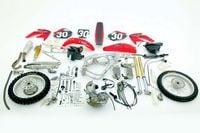
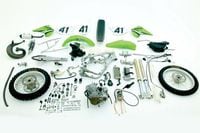
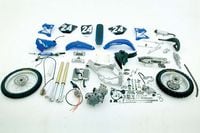
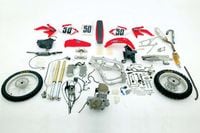
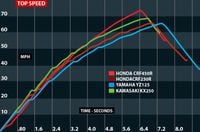
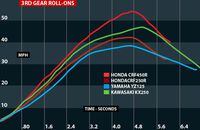
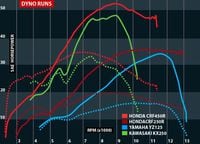
/cloudfront-us-east-1.images.arcpublishing.com/octane/KQUVDTNB6VF53CRDNN47BE3VUA.jpg)
/cloudfront-us-east-1.images.arcpublishing.com/octane/3T32INAZQRGPXOGGA36NQJDSSM.jpg)
/cloudfront-us-east-1.images.arcpublishing.com/octane/EPLS5PBKXBHNXK7S5O7G4ND3YQ.jpg)
/cloudfront-us-east-1.images.arcpublishing.com/octane/MNGOZAGZFZBH5DPFV7NOPF5S3Y.jpg)
/cloudfront-us-east-1.images.arcpublishing.com/octane/VGJWIIFM2VBCXG34KRQ37GCP7U.jpg)
/cloudfront-us-east-1.images.arcpublishing.com/octane/2ZU3HXRPMZESJF7HDLZJV7FHEY.jpg)
/cloudfront-us-east-1.images.arcpublishing.com/octane/VVFWQBZEIZDVJHZIW5ISKWKOZU.jpg)
/cloudfront-us-east-1.images.arcpublishing.com/octane/7T7FZXHIIBDX7AOBD5S3IICUJI.jpg)
/cloudfront-us-east-1.images.arcpublishing.com/octane/T3Y7A52TXBEBJNEPGOQSVPQSPU.jpg)
/cloudfront-us-east-1.images.arcpublishing.com/octane/KY33U3WBTNFIBJFMTEF2SM7BOQ.jpg)
/cloudfront-us-east-1.images.arcpublishing.com/octane/JNPS5MGVXJC7BARVMARYQIQHXE.jpg)
/cloudfront-us-east-1.images.arcpublishing.com/octane/63N2P6SYAZDURJDO5KARQYX2J4.jpg)
/cloudfront-us-east-1.images.arcpublishing.com/octane/C72WX35SXFETTO5OVA2RWT523I.jpg)
/cloudfront-us-east-1.images.arcpublishing.com/octane/F3ER37EV2RGY5CRYFNTWE3JSF4.jpg)
/cloudfront-us-east-1.images.arcpublishing.com/octane/L65QCUR32RH2NKCUHXYHHAPDFI.jpg)
/cloudfront-us-east-1.images.arcpublishing.com/octane/VSK246VVRRDMBNQU7B2NTNY6AE.jpg)
/cloudfront-us-east-1.images.arcpublishing.com/octane/CG64RRFAYRENNAP2AA22T2LSJY.jpg)
/cloudfront-us-east-1.images.arcpublishing.com/octane/IKZSRLBWMRDORMORBXSISL4D6M.jpg)
/cloudfront-us-east-1.images.arcpublishing.com/octane/BJLVRPJSDFC3ZLPMW3LYYHMPZE.jpg)
/cloudfront-us-east-1.images.arcpublishing.com/octane/RQW2RFU4MJDYRPVFJNW362SEXU.jpg)
/cloudfront-us-east-1.images.arcpublishing.com/octane/CGQDU7HEEBBWBLF6SMXCJIW7DI.jpg)
/cloudfront-us-east-1.images.arcpublishing.com/octane/B35XXACE4ZGU5BWSEMEFUL6SN4.jpg)
/cloudfront-us-east-1.images.arcpublishing.com/octane/TDSGY4VSSRC4LP6PYXP62U236Y.jpg)
/cloudfront-us-east-1.images.arcpublishing.com/octane/4YWNAG64EZF63AQI3VL7ANERSY.jpg)